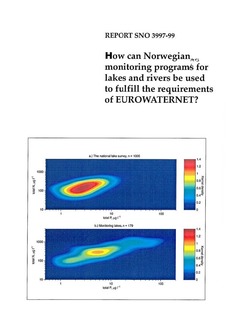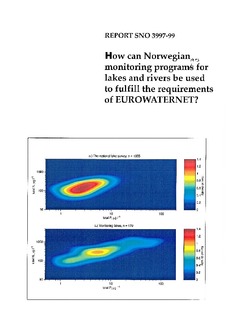| dc.contributor.author | Fjeld, E. | nb_NO |
| dc.contributor.author | Henriksen, A. | nb_NO |
| dc.contributor.author | Traaen, T. | nb_NO |
| dc.contributor.other | Ulstein, M.J. - Project manager | nb_NO |
| dc.coverage.spatial | Norge | nb_NO |
| dc.date.accessioned | 2014-08-01T10:43:16Z | |
| dc.date.available | 2014-08-01T10:43:16Z | |
| dc.date.issued | 1999 | nb_NO |
| dc.identifier | 3997 | nb_NO |
| dc.identifier.isbn | 82-577-3594-9 | nb_NO |
| dc.identifier.issn | 1894-7948 | nb_NO |
| dc.identifier.uri | http://hdl.handle.net/11250/210278 | |
| dc.description | Årsliste 1999 | nb_NO |
| dc.description.abstract | The European Topic Centre on Inland Waters (ETC/IW) has designed and tested an information and monitoring network, called EUROWATERNET. Technical Guidelines for Implementation of EUROWATERNET has been worked out, which gives the defintion and concept of the network, as well as guidelines for selecting river stations, lakes and groundwater. The Guidelines have been tested for selection of lakes and rivers based on existing Norwegian monitoring programmes. The national lake survey of 1995 (n=1005) gives the water chemical characteristics representative for the whole lake population in Norway. A method for adjusting for non-random sampling was applied in order to provide representative water chemistry statistics (total nitrogen and phosphate) from a biased sample of monitoring lakes. These monitoring lakes (n=179) were selected in order to give a good coverage also of mesotrophic and eutrophic lakes. Bivariate Gaussian kernel density estimates were used in order to obtain smoothed frequency distributions of N and P for the two datasets. These frequency distributions were then used to estimate different weights for the lakes in the monitoring lake data set. By applying these weights in the statisical calculations, water chemistry statistics representative for the whole population of Norwegian lakes can be calculated - based on data from a biased sample of monitoring lakes. To design a river monitoring program similar to the lake monitoring programme would require knowledge of the properties of an unbiased sample of the river population in Norway. | nb_NO |
| dc.description.sponsorship | Statens forurensningstilsyn (SFT) | nb_NO |
| dc.publisher | Norsk institutt for vannforskning | nb_NO |
| dc.relation.ispartofseries | NIVA-rapport;3997 | nb_NO |
| dc.rights | Navngivelse-IkkeKommersiell-DelPåSammeVilkår 3.0 Norge | nb_NO |
| dc.rights.uri | http://creativecommons.org/licenses/by-nc-sa/3.0/no/ | nb_NO |
| dc.subject | undersøkelser-ferskvann | nb_NO |
| dc.title | How can Norwegian monitoring programmes for lakes and rivers be used to fulfil the requirements of EUROWATERNET? | nb_NO |
| dc.type | Research report | nb_NO |
| dc.rights.holder | Norsk institutt for vannforskning/Norwegian institute for water research | nb_NO |
| dc.subject.nsi | VDP::Matematikk og naturvitenskap: 400 | nb_NO |
| dc.source.pagenumber | 14 | nb_NO |
| dc.subject.keyword | overvåking | nb_NO |
| dc.subject.keyword | innsjø | nb_NO |
| dc.subject.keyword | elv | nb_NO |
| dc.subject.keyword | næringssalt | nb_NO |
| dc.subject.keyword | monitoring | nb_NO |
| dc.subject.keyword | lake | nb_NO |
| dc.subject.keyword | river | nb_NO |
| dc.subject.keyword | nutrient | nb_NO |
| dc.relation.project | O-95028 | nb_NO |


